Home
Goals
Participants
Critters
Maps
Cnid ToL
|
Meg, Tim, and Kensuke Travel to Hokkaido
July 30 - August 9 |
|
July 30
Tim and Meg traveled north to meet up with Kensuke Yanagi, a colleague of Meg’s and the
Japanese authority on sea anemones. Meg, Tim, and Kensuke traveled together for 10 days through Hokkaido and Northern
Honshu, looking for sea anemones and hydroids. |
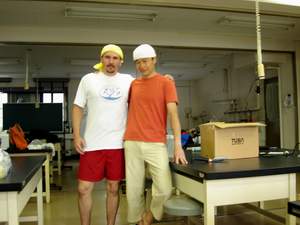
|
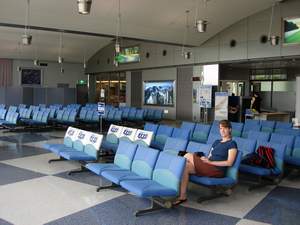
|
Our trip started at the Shirahama airport, which is the
smallest airport either of us have ever traveled through. The airport serves only Japan Airlines, and has a single gate.
The young woman who checked us in and gave us boarding passes was also the person who ran gate security, and who took
our tickets at boarding. We were among the first passengers there!
|
| On the flight between Shirahama and Haneda, the crew gave instructions
and information in Japanese and English-- because we were the only non-Japanese people on the plane, we both felt that we
had to pay attention to all the English instructions out of politeness, as they were doing it for our benefit. On this brief
flight we saw a beautiful panorama of Japan, including the tip of Mt Fuji, which projects into the clouds.
As we deplaned from the flight between Haneda and Kushiro, we intersected with Kensuke, who had been sitting several rows
behind us. We picked up the rental car he had arranged—they drive on the right side here, and all the signs are in Japanese,
with only the names of places transliterated into the Roman alphabet, so he was doing all the driving. The car has a really
amazing talking GPS navigator that prompts you with directions to your destination—Kensuke and Tim were very excited
about this. Meg was most excited to realize that there were 3 different cartoon characters acting as the persona of the
navigation system: a woman in a business suit, a young woman in shorts and a t-shirt and a woman in a pants suit. We could
detect no pattern to the deployment of the various personae.
|
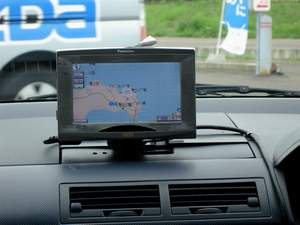
|
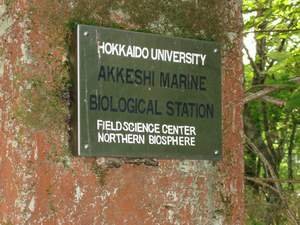
|
Akkeshi Marine Biological Station is about an hour
North of Kushiro Airport, in eastern Hokkaido. Hokkaido is cooler than Shirahama by about 30 degrees Fahrenheit, and
incredibly green. The landscape is breathtaking—mountains, wide bays, deep, dark forests. Kensuke told us that some
place names here are derived from names given by the Ainu, the historical inhabitants of Hokkaido, and are thus hard
for the Japanese to pronounce—we were glad we weren’t the only ones having trouble pronouncing things!
|
| Our poor rental car got quite a work-out. The station lies at
the end of a long, steep hill, on a winding, rutted dirt road. The hill is so steep that we almost couldn’t get back up
last night when we left for dinner—Kensuke had to pop the handbrake and use the lowest gear, and still the engine groaned
and complained.
When we returned from dinner, we left the car at a flat spot before the worst of the hills and walked back
in complete blackness, guided by the light of Kensuke’s cell phone. The station comprises 2 buildings—the main office and l
ab, and the guest housing and guest labs. Tim and Kensuke have a beautiful Japanese style room with
tatami mats. Both buildings face Akkeshi Bay, which is broad and calm, and bordered by wooded hills.
|
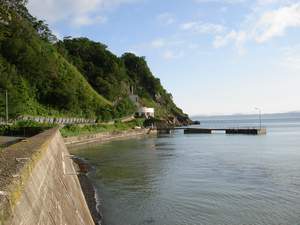
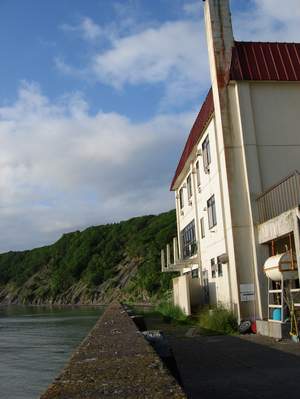
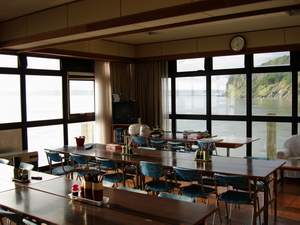
|
July 31

|
Our first morning was grey and misty, but that didn’t stop us
from getting right down to business. We traveled 2 hours north to a bay where Dr. Mukai, the director of Akkeshi station
and an expert on sea-grass ecology, has seen Metaedwardsia akkeshi, a species Meg was really keen to collect.
Metaedwardsia akkeshi was originally described from Akkeshi Bay by the very first director of the Marine station,
Dr. Torhu Uchida.
|
| Our drive was incredible. We traversed a huge freshwater marsh
that is largely protected as a National Park. There are native iris in the field here—tall, and a deep purple,
and rugose roses with gigantic spiny hips. We felt fortunate to see several groups of red-crested cranes feeding in the
marshes, and in flight above them.
|
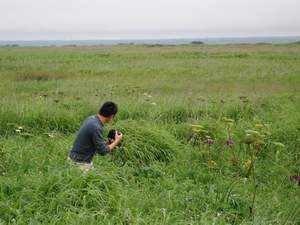
|
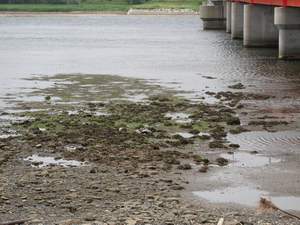
|
Our first site was near islands that are claimed by both
Japan and Russia (Japan lost them after WWII). Tim and Meg really liked the idea that they were collecting near Russia,
and the chilly wind blowing through the fields made it seem all too possible! About 100 feet from the car, on the
way to the place Dr. Mukai had recommended, Meg stopped to pick up a little starfish that had been stranded by the
receding tide, and noticed patches of eelgrass. After a hard look, she stuck in her trowel and pulled out Metaedwardsia!
We gave up on the hike, and collected where we stood. Tim abandoned Meg and Kensuke to look for hydroids, which are not so
common on mud flats, but he found some rockier patches under a bridge, and managed to collect a couple of colonies.
|
| Since we had been so successful so quickly, we went on to another site,
an hour north again and around a bay. We took a short pitstop at one of the MANY vending machines along the side of the road,
and got really good coffee in a can (like soda, but hot, and coffee). Vending machines are everywhere here, and sell
everything (beer, juice, soda, hot drinks, soup). The brands are mostly unfamiliar (though they have the trinity of
international beverages: Coke, Pepsi, and Fanta). Coke sells a really tasty juice drink called “qoo” with a very cute logo,
there is a Pepsico ion water called “Pocari Sweat” and the coffee we drank was a local brand (Suntory) called “Boss Coffee”
with the icon of a little mustachioed boss on it.
|
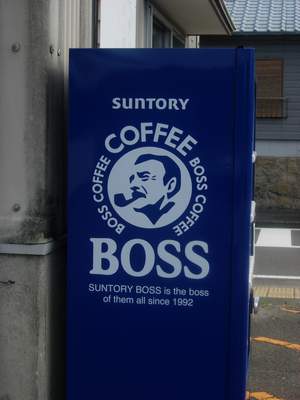
|
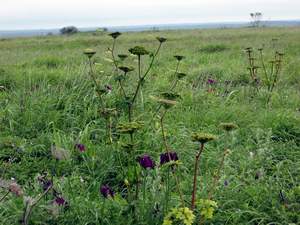
|
Our second site was at the mouth of Lake Furen. It is a
fantastic marshland, with waist-high grass, irises, and tons of birds. The land formed a narrow spit between an inlet
and the sea, and at the end, there was a man-made pier of concrete “jacks” (shaped like the toys) stacked 3 or 4 deep and
3 or 4 high. Tim climbed INSIDE the jack-stack and found hydroids.
|
August 1
Today was our first dive day.
We went diving near a small rocky island at the mouth of Akkeshi Bay. We had a series of minor mishaps: Tim got an
empty tank by accident and Meg lost her weight belt underwater. Tim gave Meg his belt, and sat out for this dive.
The water was about 11 degrees Celsius, and to say it was cold is a gross understatement—the water was so cold that
hands and lips first hurt, then went numb. We swam about 100 meters to the island, collecting a few anemones and 2
kinds of stauromedusae from the kelp and algae as we went.
|
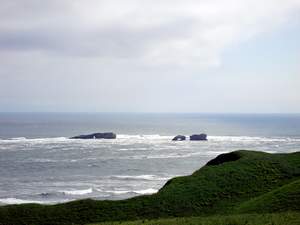
|
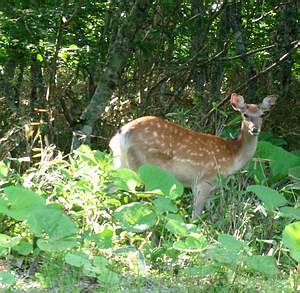
|
In the afternoon, we went to the local natural history museum,
where they had stuffed specimens of local birds and mammals. We have seen many of the native deer, a flock (herd?)
of which live in the woods near the station. After that, we spent some time with the things we collected,
then ate dinner and had an early night. Tim was really tired—his crazy travel caught up to him, and we had an early
exit to catch the train to Hakodate (southern Hokkaido).
|
August 2
Hakodate was a brief
stay on our way to Asamushi Marine Station, just across the water in Northern Honshu. Kensuke chose Hakodate because
Asamushi wasn’t ready for us yet, and because Aomori, the city nearest the station, was full of visitors to its famous
Nebuta festival. Like so many of Kensuke’s decisions, Hakodate proved to be an inspired choice. This seaside town is
home to its own festival, this one in honor of squid, the town’s mascot and an important part of the fishery there.
|
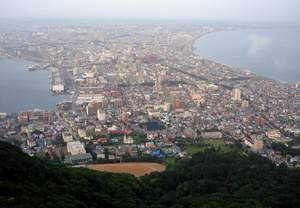
|
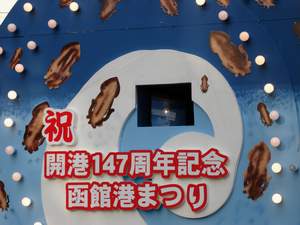
|
When we left our hotel in the afternoon to do a little sight
seeing, we were stopped by a parade. Kensuke asked the police man what was going on, and we discovered that today
was the "squid festival", featuring their famous squid dance.
|
| The squid dance consists of a crowd of people clapping
and shouting and flailing in unison as he names of various squid dishes are chanted (imagine the "chicken dance," but for squid).
After several rounds everyone waves their hands left, right, left, right at increasing speeds, then does the wave forwards,
then backwards. The crowd that danced and chanted its way through the town included grandmotherly women, salary men on their
way home from work, children, college students dressed in drag and as cartoon characters (one kid dressed as a mushroom),
and 3 cnidarian biologists. We danced the whole route (about an hour), making the motions and chanting "Hai" when each
dish was mentioned.
|
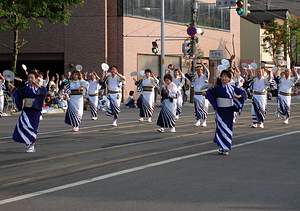
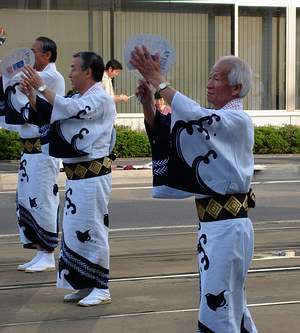
|
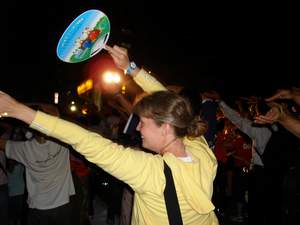 |
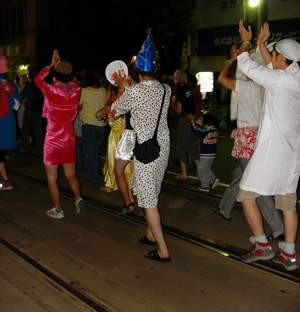
|
| In Hakodate, we also found an unusual vending machine,
custom-made for Meg.
|
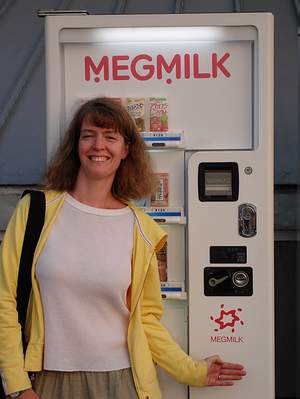
|
August 3
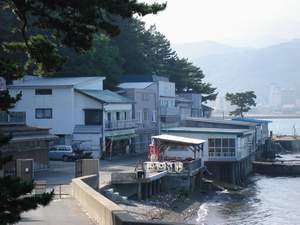
|
Asamushi Marine Biological station is on Mutsu Bay, the little
bowl-shaped indentation on Northern tip of Honshu, just across the straits from Hokkaido. It is in a very small beach town
just outside the prefecture capital, Aomori.
|
| The station is large and really well equipped, with a beautiful view
of 2 rocky islands. We have a HUGE lab all to ourselves, with fabulous microscopes and plenty of room to spread out.
|
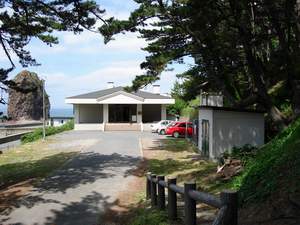
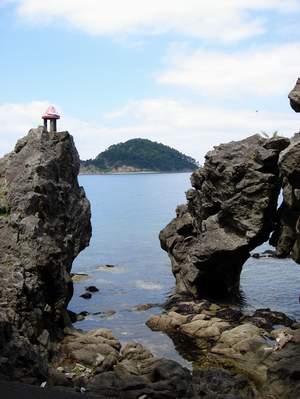
|
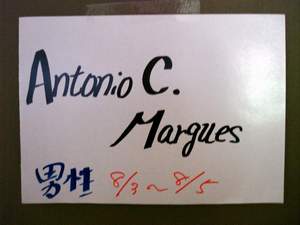
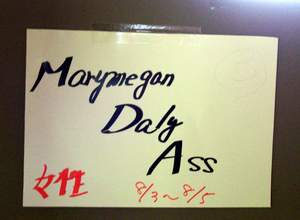
|
Hanging on our doors were our names...Meg seems to have an
addition to hers.
|
| Our rooms here are Japanese style, which is still a novelty--you’d think after 2 weeks the novelty would wear off,
but it hasn’t! The kitchen is harder to negotiate than in Shirahama or Akkeshi—it isn’t left open for us at night or in
the morning, so we have to eat out or get food to bring back, and there’s no hot coffee or tea in the morning (O, the horror!).
We have been eating lunch at little stands that line the path between town and the station—small noodle restaurants that perch
on the sea wall on one side and are on stilts over the shore.
|
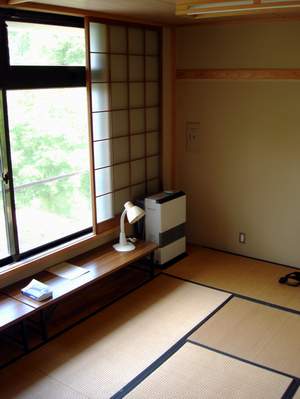
|
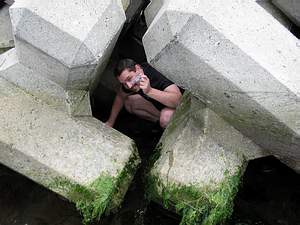
|
We are diving both days we’re
here in Asamushi. The water is warm compared to Hokkaido, but the conditions are sub-optimal,
with limited visibility and strong currents and PLENTY of algae. We have managed to find several species
we had not collected in Hokkaido, and are happy with the progress we’re making.
|
| And just look at how we get to end our days. Beautiful!
|
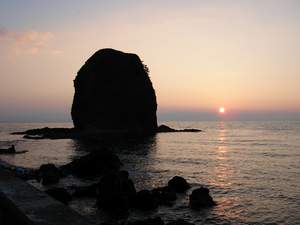
|
August 4
Kensuke and
Meg went out at low tide to try to find specimens belonging to Anthopleura atodai, a species they
described together a couple of years ago. We waded out to a little island, and spent about an hour
searching but it is apparently no longer here.
Instead, we collected some specimens of Anthopleura inornata. The largest of these
specimens released sperm when we brought it back to the lab!
|
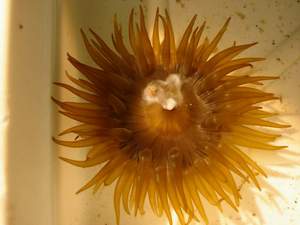
|
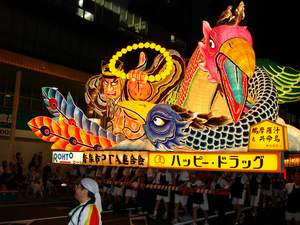
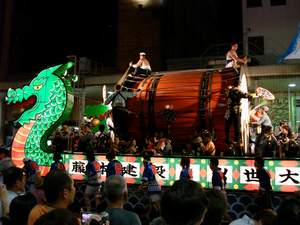
|
At night, we went to the Nebuta festival in Aomori
City, about 20 minutes away via train. The big attraction in Nebuta is a parade of GIGANTIC rice paper
lanterns in the shape of warriors, mythological creatures, and various corporate sponsors.
These elaborate
floats are on wheels, and are pulled by a team of people whose movements are synchronized by a gigantic
drum set (3 or 4 drums about 10 feet in diameter) played with long, curved sticks. After each float,
there is a team of about 50-100 dancers in traditional dress, with bells pinned to their clothes—as
they dance, the bells jingle in counterpoint to the drums.
|
August 5
Today we
are taking the Bullet (or “Bullep”, as the LittleGuy says) train to Tokyo on our way, to the city
in Chiba where Kensuke lives. Even cooler than the aerodynamic and futuristic Bullet train was
the train station in Tokyo. It absolutely dwarfs all other stations Tim or Meg have ever been in,
comparing more to an international airport than a train station in terms of size or activity. We
had 35 minutes between trains, and even with the hustle we put on and Kensuke’s considerable
experience, we barely made our next train! For the first time, we got the sense of how crowded
Japan can be—we have been in the country, in remote places, or in small towns, and have not seen
many people.
|
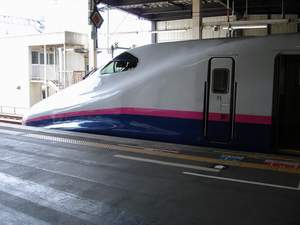
|
| We got to Kensuke’s around 4 pm and met his
wife (also a marine biologist, studying behavior and communication in marsh crabs) and young daughter.
His daughter is 19 months old and absolutely charming. At dinner, she picked up her empty rice bowl,
held it to her ear and said “Mushi-mushi?” meaning “hello?” and which is how one answers the phone.
Adorable. |
Before dinner, Kensuke suggested we visit the baths at the local resort hotel. Japanese baths aren’t
really for washing—one washes first, in a shower-room, then enjoys the hot water. The baths are in a big
hotel, and look out over a pine forest to the ocean. It felt great to relax in the water after a long
day of travel—what a treat.
|
| Afterwards, we had dinner at Kensuke’s house.
They prepared an amazing spread of small dishes, rice, and fillings, and we made hand rolls (temaki) from:
asparagus, cucumber, avocado, watercress, shiso leaf, omelet strips, smoked salmon, tuna, grilled eel,
pickled daikon, pickled cucumbers with ginger, fermented soybeans, squid, mackerel, ham, and beef with
garlic. There was also lettuce, cold seasoned tofu, and a seaweed salad. For dessert we ate agar cubes
(like jello, but firmer, and made, like so much here, from sea weed) with mandarin oranges and sweet
red beans and drank sake (much better here than typically available in the US). This was BY FAR the
best meal we have eaten in Japan, in terms of the food and the excellent company.
|
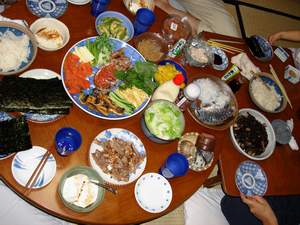
|
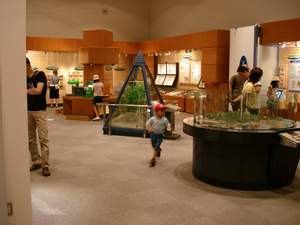
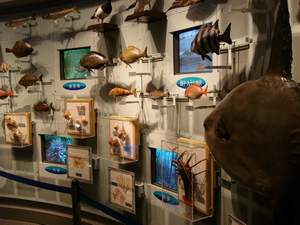
|
August 6
Today
we visited the coastal branch of the Chiba Museum of Natural History, where Kensuke works. The museum
has wonderful displays of local flora and fauna, with an emphasis on looking and touching. They have
a bank of fish skins you can touch, with the picture of the fish it comes from on the reverse, and a
really neat display of the holes you see on the sea shore, and what lives inside. The museum is
state of the art, with video and music, but this is all very discreet and well-integrated into the
displays, so that the focus is on the natural history rather than the technology. The beach (where
we went collecting this am) is about 100 yards from the front door, and they use the natural areas
like an extension of the exhibits.
|
August 7
We are
spending 2 days at Tateyama field station, which was Kensuke’s “home” station when he was a student.
We arrived at night on the 6th, and got up early for diving. On our first dive, we visited a site in
the company of a bunch of recreational divers. The dive shop that maintains the site has erected a
giant shrine underwater—a huge wooden gate (torii). We saw the shrine, but didn’t linger there—the
site was really rich in animals for Tim, and so we spent all of our underwater time with our faces
pressed to rocks, looking for tiny colonies of hydrozoans. Although we saw some fantastic anemones,
we couldn’t collect them—the dive shop had asked us not to collect any of the larger animals because
it would decrease the diversity of things the dive tourists would see. The dive conditions were the
best yet—the water was clear, and visibility was about 10 meters (meaning you can see underwater for
about 35 feet).
|

|
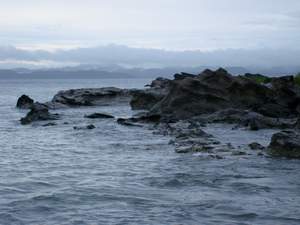
|
After an hour’s rest at the surface, and a
small snack, we headed back out for a second, shallower dive. While we were resting, the jovial man
who runs the dive shop bestowed little presents on us: Shinto good luck charms to hang on our dive
vests and a really cool sticker for the case for Meg’s underwater camera.
|
| On the way to the second site, we were able
to see Mt Fuji in the distance—the skies here are pretty hazy because of humidity and pollution for
the city, and seeing Fuji is apparently a rarity in summer. On the flight to Hokkaido, we saw the
top part above the clouds, and here we saw the bottom part, below them, so we have now seen the
whole thing.
We hit the jackpot here for Luciana, collecting 2 hermit crabs, each with several
giant specimens of her anemone on them.
|
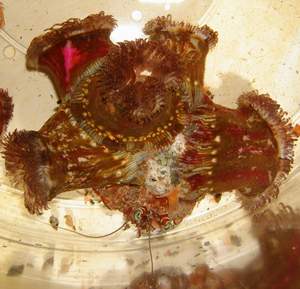
|

|
After the dive, Kensuke headed back home.
Tim was really sad to see him go. Meg’s sadness was tempered by the knowledge that they would meet
up again after O-bon to do some collecting with Luciana on the Boso Peninsula. Kensuke has been a
fantastic guide, and has made the trip both more productive and more fun than it would have been
otherwise.
|
| Unlike anemones, which are large and
relatively hardy, hydrozoans are tiny and die quickly after collection. Tim sat at the scope,
looking at his little beasties from our return at 1 pm until 3 am. He took a small break from
7:30 until 9, when we had an excellent dinner at the home of Dr. Sunobe, the director of
Tateyama station. Like all of the researchers we have encountered on our tour, Dr. Sunobe has
been incredibly helpful with logistical arrangements and on-site support, and has also been a
gracious and thoughtful host. We feel really lucky to have met so many interesting people on
this trip.
|
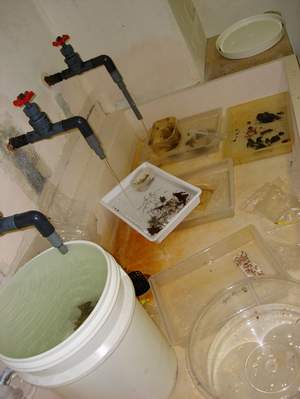
|
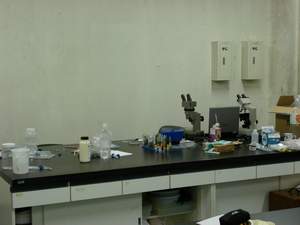
|
Sometime in the night, as Tim worked away
and Meg slept, it began to rain. Although this complicated our plan for working at the 10:30 low
tide, we braved the rain and picked up a few samples. The rain gave us time to get our gear packed,
clean the lab, catch up on email, and begin to plan the next phase of our trip….
|
|

